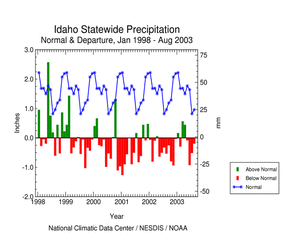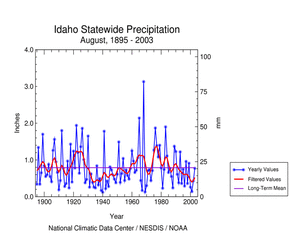|

|
|
Tree-ring data from the northern Rockies (specifically the central Idaho and western Montana mountains) were analyzed to create a reconstructed summer (June-August) Palmer Drought Severity Index (PDSI) for the last 700 years. The top graph to right shows how the reconstruction (from 1900-1990) compares to the observed PDSI (from 1900-2003). The current drought has continued in this area for the last five years, reaching severity levels as extreme as the 1930s, which was the worst drought of the 20th century by this measure.
The bottom graph to the right shows the individual summer reconstructed PDSI values for each year (gray curve) and the longer-term variations (red 20-year low pass filtered curve) for 1306-1990. The annual values (gray curve) indicate that summer droughts have been as severe or worse during the last 700 years as the most severe 20th century drought (1931), specifically 1492, 1657, 1677, 1717, 1721, 1756, 1783, 1800, 1863, and 1889. A prolonged period of drought occurred during the mid-1600s, but the 1930s stands out (red curve) as the most severe drought episode in terms of combined severity and duration.
|
 graph showing reconstructed Palmer Drought Severity Index for northern Rockies, 1306-2003 |
|
The general methodology of the tree-ring reconstructed Palmer index is discussed by Cook et al., 1999. An earlier version of the PDSI reconstructions is available online from the NOAA Paleoclimatology Branch http://www.ngdc.noaa.gov/paleo/pdsi.html (the data displayed will be available in winter 2004).
Reference: Cook, E.R., D.M. Meko, D.W. Stahle, and M.K. Cleaveland, 1999. "Drought reconstructions for the continental United States." Journal of Climate, 12:1145-1162. |
 NCDC /
Clim. Monitoring /
Climate-2003 /
Aug /
U.S. Regional Drought /
Search /
Help
NCDC /
Clim. Monitoring /
Climate-2003 /
Aug /
U.S. Regional Drought /
Search /
Help
Downloaded Saturday, 04-Oct-2008 10:53:07 EDT
Last Updated Friday, 18-Nov-2005 14:11:45 EST by Richard.Heim@noaa.gov
Please see the NCDC Contact Page if you have questions or comments.






